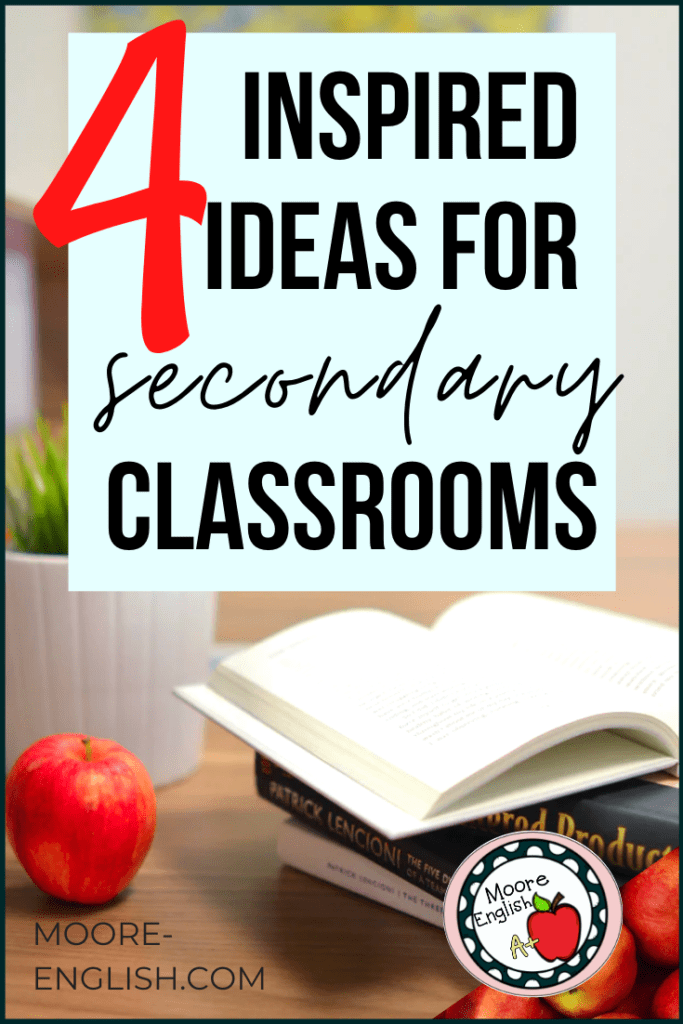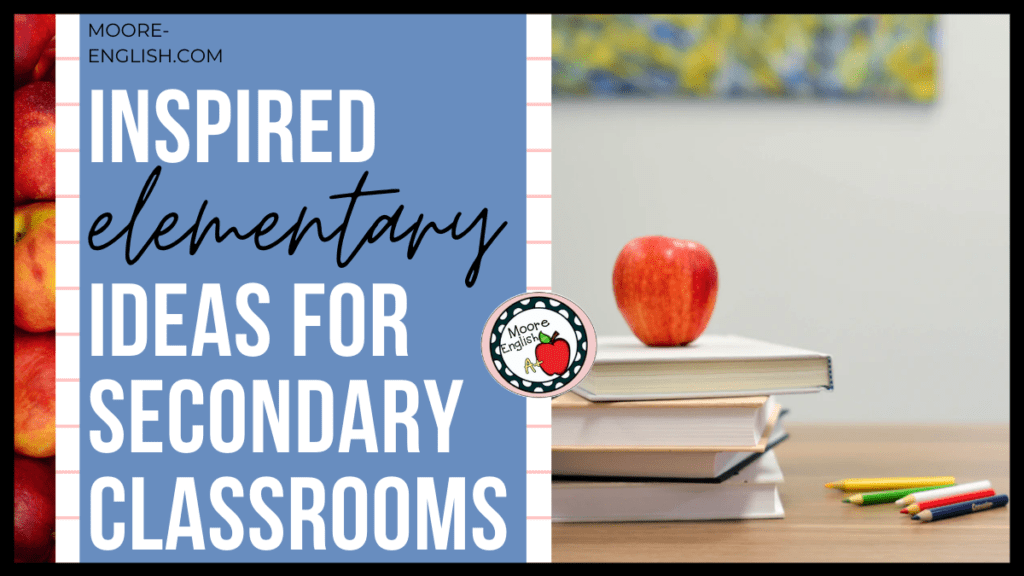Once a month, I get together with the women from my Masters cohort. It’s been a wedding, two babies, and three grade-level changes since we finished our degree program. But we still get to get together. Of the five of us, I’m the only high school teacher. Everyone else teaches elementary.
Last week was our June get together. Knowing that my friends had a wide range of experiences, I asked about flexible seating. My friends gave me some great suggestions for implementing flexible seating. And that conversation made me reflect on the number of seemingly elementary ideas that have improved my secondary classroom. Here are the *elementary* ideas that you should try in your secondary classroom:
This post this post may contain affiliate links. Please read the Terms of Use.
Anchor Charts
I cannot pretend to know where anchor charts originated. But sometimes anchor charts get tagged as being elementary. Anchor charts are visual cues for students. At the secondary level, anchor charts can help students master annotation, internalize algebraic formulas, or establish behavior norms.
I didn’t fully appreciate power of anchor charts until a few years ago during standardized testing. Of course, testing required that we take down all of our anchor charts and any other content-related visuals. But as my students were testing, they continued to look to the wall where the anchor charts used to hang. That’s when I realized how much anchor charts help students visualize and internalize content! Now, in my classroom, we use anchor charts regularly–for establishing norms, for casting plays, and for everything in between.
Anchor Chart Truths
- Anchor charts can be as cutesy as you’d like. But mine are not really Pinterest-worthy.
- Instead, my students and I always build our anchor charts together (which can mean that I end up with multiple copies of the same chart).
- Then, we reference the anchor chart regularly, making it part of our instruction.
- As our understanding of a concept develops, the anchor chart also evolves.
- Students can also make mini-anchor charts to copy or paste into their notes, too.
Task Cards
Again, I do not know the origins of task cards, but this year I wanted to incorporate more meaningful movement into my instruction. Task cards were one way I could tie movement to instruction. But I didn’t really know much about task cards. Making task cards wasn’t the problem–PowerPoint gives you lots of options for making task cards (free template here). But I needed some guidance on how to implement task cards. My co-workers weren’t using them, and my Masters cohort didn’t have a ton of advice. So I turned to the Internet. The most helpful article I found was this one from Jenn, the Teacher Next Door. Based on her advice, I tried task cards a few different ways. These are my favorite options:
- Matching or Concentration: When students are meeting a concept for the first time, a matching or concentration-style game can be an effective way to help students work on identifying. This is how task cards can support scaffolding. For example, when students are first encountering literary criticism, a matching or concentration style set of task cards like this one can be especially helpful.
- Small Groups Freestyle: When we are a little further into a unit, I will divide students into small groups and randomly divide the task cards. This is how task cards can support formative assessment. Every group gets the same number of cards and, if I’m really on my game, each group gets the same kinds of cards. For example, each group might get one inference card, one text-connections card, one summary card, one vocabulary card, and one citation card. This gives me an idea of where students are at in a unit and helps me plan for the next activity. For example, when my students play the Parallelism Game, most of them are not acquainted with parallel structure at all, so this set of task cards meets leads them through next content.
- Small Groups Planned: After everyone tries all the types of task cards, I get an idea of which students are struggling with which skills or concepts. That’s when I go back to the drawing board, restructure my groups, and then I “stack the deck.” This means that I might have one group focusing on citation and summary while another group focuses on vocabulary, and I work with a group focused on inference. This is how task cards can support differentiation. For example, as my students read The Great Gatsby, I arrange this set of task cards and distribute them to students and groups based on need.
Visualization
In the past, I have written about the importance of visualizing content as a way to make connections and build scaffolding. At one point in my teacher life, visualizing was something I blew off. Thank goodness I learned from that misconception. Sometimes the perception of secondary education is that students receive information and then magically get it. But that’s not how learning works. Students need time and space to work with new material, to practice new skills, and to assimilate and accommodate new content. As Peter Elbow says, there is violence in learning. Here are some visualization suggestions from elementary teachers that I think are worth a read:
- Not many secondary teachers have a data wall, so when I decided to go all in with my data wall, I wanted to study best practices. This article from Jessica of What I Have Learned was particularly helpful. My classroom data wall (and these individual data sheets) help students visualize their growth and goals. This way students are seeing how they have changed the content and how it has changed them.
- Until I read this article from Melissa at Teacher Thrive, I hadn’t considered using timelines in grammar. The idea of incorporating timelines into grammar instruction could be especially helpful for English learners, and I am excited to try this visualization strategy in my classroom next year.
Flexible Seating
When I talked to my Masters cohort about flexible seating, I got a variety of reactions. Some have gone all in on flexible seating and love it. Others have had mixed results. With the construction to our building, we will have new furniture in the next two years, and it’s designed for flexible seating. So even if I have had trepidations about using flexible seating in the past, it’s probably part of my future. With this in mind, I wanted to get some feedback about best practices. My elementary friends did not disappointed. Their first suggestion was to establish, maintain, and revisit expectations as needed. In other words, be flexible with seating, not with expectations. Similarly, they also suggested framing flexible seating as a privilege, not a right. Recently, Keeping Up with Mrs. Harris also shared her ideas for implementing flexible seating.
Epilogue: It’s Not Elementary
Bottom line: there is elementary content (ABCs, addition/subtraction, etc.), but there are not necessarily elementary teaching strategies. Good instruction is good instruction regardless of grade level. Whether you try one or all of these strategies in your secondary classroom, it’s more important to focus on what value the instruction can bring to your learners than on where the instructional strategy originated. What *elementary* ideas or strategies have helped your secondary learners? Let us know in the comments.


Photo by Element5 Digital on Unsplash






















